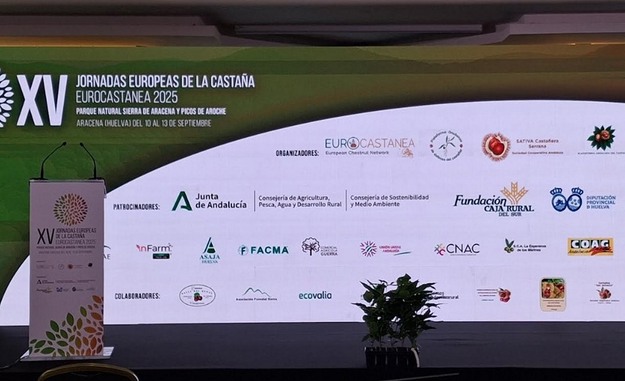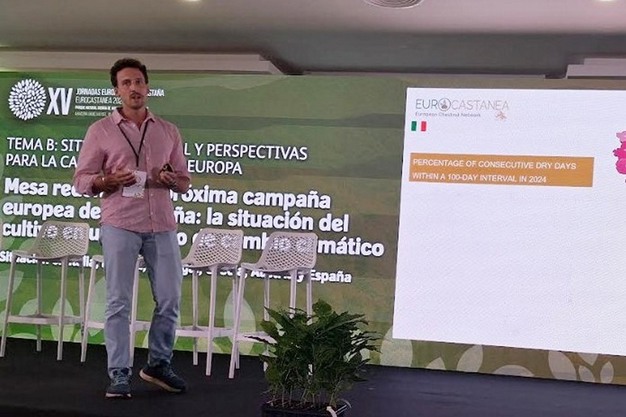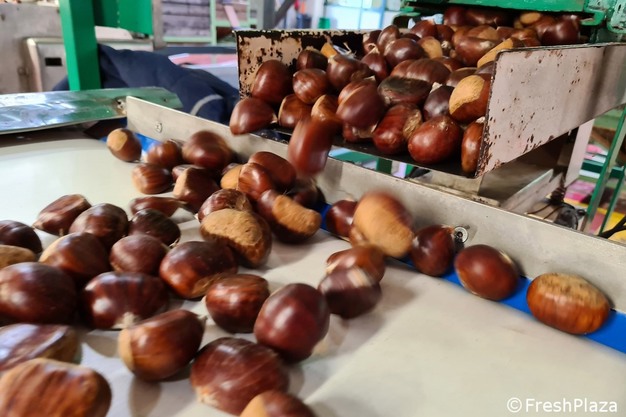From 11 to 14 September, the town of Aracena hosted the 15th European Chestnut Congress, Eurocastanea 2025. This annual event is held in a chestnut-growing region selected by the host country. Spain was chosen as the host country for 2025. It was the first time the congress was held in Andalusia, specifically in Aracena, a town in the northern part of the province of Huelva within the Sierra de Aracena y Picos de Aroche Natural Park.
The area is renowned for its PDO Jabugo Ibérico Ham and for cultivating chestnuts across more than 5,000 hectares, with over half of the 12,000 hectares cultivated in Andalusia. Chestnuts and ham are essential to the area's economic, tourist, and gastronomic development.
 Photos provided by Luciano Trentini
Photos provided by Luciano Trentini
The European Chestnut Network, which includes six member countries (Italy, Portugal, Spain, France, Austria, and Greece), hosted over 200 delegates from nine European, South American, and Western Asian countries. The event provided an opportunity to discuss various topics, share experiences, and promote innovation and sustainability in the chestnut ecosystem.
An Italian delegation representing the national production sector was attending the event, including the Chestnut and Marron District of Campania; the Association of Consortia of Chestnut Growers of Emilia-Romagna; the CSDC (Study and Documentation Center on the Chestnut of Marradi); the universities of Bologna, Turin, and Viterbo; the Chestnut Research Center of Chiusa Pesio in Piedmont; the Laimburg Research Center in Bolzano; and companies active in the sector, such as In Farm and Facma.
Climate change was a key topic of discussion, as it is causing serious damage to chestnut cultivation across Europe. Particular reference was made to the devastating impact of wildfires in Portugal, Spain, and Greece, which have severely damaged thousands of hectares of chestnut groves, significantly reducing the amount of product available on the market. Other major climate-related challenges include prolonged high summer temperatures and intense spring rainfall. These challenges threaten the stability of European production. Overall, data analysis suggests that output in 2025 will be similar to or slightly lower than that of 2024.

All of this information comes from studies conducted by countries that are part of the European Eurocastanea network. The findings clearly show that climate change is one of the sector's main challenges, directly affecting yields and quality. Based on these studies, low rainfall and increasingly frequent heat waves hinder fruit ripening in several European production areas. In particular, summer drought conditions threaten to reduce production further in Portugal and Greece due to a notable reduction in fruit size.
As of mid-September, Italy's production outlook is mixed but better than in other European regions, according to data from qualified industry experts. In the north, despite severe weather events and heavy rainfall at the end of August, the fruit had a good ripening period. Favorable weather and climate conditions in central Italy suggest increased production compared to the past three years. In southern regions, prolonged summer droughts and the reappearance of the chestnut gall wasp in some areas could lead to significant production drops. Much will depend on the weather in the coming weeks.
A concerning outcome of the conversations among the speakers was the resurgence of ink disease in many chestnut-growing regions. Effective integrated management practices and tolerant rootstocks, which are currently under evaluation, could help contain the spread of this pathogen. There are also reports of the Chinese chestnut gall wasp returning to some European regions. However, it does not currently appear to cause significant damage. The European protocol developed by Eurocastanea researchers to combat Gnomoniopsis, also known as chalky rot, offers promising solutions, though they are not yet conclusive.
 Giovanni Gamba of the University of Turin (UniTo) explains Italy's climate situation before presenting the production forecast
Giovanni Gamba of the University of Turin (UniTo) explains Italy's climate situation before presenting the production forecast
Giacomo Gatti's report from the Laimburg Experimental Center sparked significant interest in this topic. He discussed preserving chestnuts and marrons, emphasizing that they should be treated like fresh fruit. In recent years, climate change has revealed that these fruits have been incorrectly grouped with nuts. Nuts are actually shelled fruits. Safeguarding the quality of these products requires a new approach to maintaining the cold chain, which is essential to ensuring the health of the fruit and the success of the entire supply chain.
Professor Rodriguez of the University of Salamanca delivered an engaging presentation that emphasized the importance of environmental services derived from the chestnut ecosystem. Currently, chestnut growers are not compensated for their contributions to tourism, the environment, carbon sequestration, landscape preservation, or reduced hydrogeological risk. Professor Rodriguez's study aimed to assign an economic value to the work of chestnut farmers by establishing a relationship between nature, value, and the market. In Spain, the total value attributed to this activity is €8,000 per cultivated hectare.
 © Cristiano Riciputi | FreshPlaza.com
© Cristiano Riciputi | FreshPlaza.com
Luciano Trentini of the CSDC noted that several key issues related to the future of chestnut cultivation were addressed, including generational renewal and the modernization of production systems. An innovative processing strategy is also necessary to move beyond the concept of seasonality. Since chestnuts and marrons are seasonal products with a marketing period lasting only three to four months, it is essential to develop new products and commercial strategies.
Trentini concluded by announcing that the 2026 edition of Eurocastanea will be held in Portugal, followed by Italy in 2028.
For more information:
https://eurocastanea2025andalucia.com/it/
